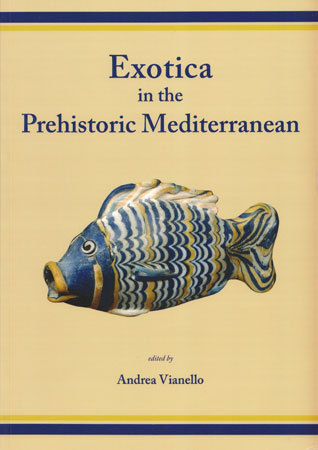Exotica in the Prehistoric Mediterranean
Andrea Vianello (επιμέλεια)

Πόλη: Oxford & Oakville
Έτος: 2011
Εκδότης: Oxbow Books
Περιγραφή: Μαλακό εξώφυλλο, viii & 216 σ., ασπρόμαυρες εικόνες και σχέδια, 34 έγχρωμοι πίνακες, 29,8x21 εκ.
Περίληψη (στα Αγγλικά)
Exotica in archaeology are usually identified as any foreign as opposed to indigenous materials and products. The presence of exotica can map movements of people and help recognise exchange networks by linking human societies with sometimes distant places. In the Palaeolithic exotica were only body ornaments, such as beads (i.e. shells) and studies of lithic tools have also demonstrated that rare materials were being sought for. From the Neolithic onwards exotica became an indicator of inequality, social stratification and hierarchy, though it is necessary to understand the social context in which they are inserted in order to appreciate their meaning.
Exotica in the Prehistoric Mediterranean examines how exotic materials were exchanged and used across the Mediterranean from the Neolithic era to the Iron Age, with particular focus on the Bronze Age. A variety of materials and interpretative approaches are presented through several case studies. These emphasise how the value of exotic materials depended on the context in which they were consumed. The book firmly departs from assumptions of fixed categories such as prestige items or corresponding values, as evident in the Amarna letters. Instead, it shows how almost any object could be appreciated or ignored depending primarily on the cultural, social and economic dynamics of individual communities. Exotica considered include Neolithic shells and salt, amber, Bronze Age glass, ivory, prestige swords and bird-shaped prows of boats.
Περιεχόμενα
Preface [v]
List of Contributors [vi]
Introduction [vii-vii]
SECTION 1. THE NEOLITHIC
1. Michel Louis Séfériadès, ‘Protohistoric Spondylus gaederopus L. Shell: some considerations on the earliest European long-distance exchanges related to shamanism’ [3-12]
2. Dragoş Gheorghiu, ‘Insignia of Exotica: skeuomorphs of Mediterranean shells in Chalcolithic south Eastern Europe’ [13-25]
3. Tomaso di Fraia, ‘Salt Production and Consumption in Prehistory: toward a complex systems view’ [26-32]
4. Robert H. Tykot, ‘Obsidian Finds on the Fringes of the Central Mediterranean: exotic or eccentric exchange?’ [33-44]
5. Heinrich C. Dosedla & Alf Krauliz, ‘Mineral Mining and Mineral Trade in Mountainous Melanesia and the Mineral zone of Morten: parallels between prehistoric central Europe and archaic societies in contemporary New Guinea’ [45-53]
SECTION 2. AMBER
6. Nuccia Negroni Catacchio, ‘Amber in Antiquity’ [56-58]
7. Ike Loze, ‘Neolithic Amber Processing and Exchange on the Eastern Coast of the Baltic Sea’ [59-62]
8. Nuccia Negroni Catacchio, ‘L’ambra e i principi guerrieri di eta orientalizzante in Italia (Amber and the Warrior Princes of the Orientalising Period in Italy)’ [63-95]
SECTION 3. THE EAST MEDITERRANEAN AND THE AEGEAN BRONZE AGE
9. Helen Hughes-Brock, ‘Exotic Materials and Objects Sent to – and from? – the Bronze Age Aegean. Some recent work and some observations’ [99-114]
10. Caroline M. Jackson & Emma C. Wager, ‘Glass in the Aegean Bronze Age: value, meaning and status’ [115-123]
11. Elora Heymans & Gert Jan Van Wijngaarden, ‘Low-value Manufactured Exotics in the Eastern Mediterranean in the Late Bronze and Early Iron Ages’ [124-136]
12. Helène Whittaker, ‘Exotica in Early Mycenaean Burials as Evidence for the Self-representation of the Elite’ [137-146]
13. Nancy R. Thomas, ‘Recognizing Niello: three Aegean daggers’ [147-162]
SECTION 4. WESTWARD HO! THE SHIPS
14. Andrea Vianello, ‘Recognising Exotica in the Archaeological Record: the case of the mycenaean exchange network’ [164-171]
15. Riccardo Gulielmino, Francesco Iacono & Michella Rugge, ‘Before the Stream: the social and economic role of exotica in the central Mediterranean. The case of ivory items from Roca’ [172-185]
SECTION 5. BROADENING THE PERSPECTIVE
16. Jan Bouzek, ‘Bird-shaped Prows of Boats. Sea Peoples and the Pelasgians’ [188-193]
17. Anthony Harding, ‘Prestige Swords of the Bronze Age’ [194-198]
18. Conclusions [199-200]
Plates [201]

Σχόλια
Παρακαλούμε τα σχόλιά σας να είναι στα Ελληνικά (πάντα με ελληνικούς χαρακτήρες) ή στα Αγγλικά. Αποφύγετε τα κεφαλαία γράμματα. Ο Αιγεύς διατηρεί το δικαίωμα να διαγράφει εκτός θέματος, προσβλητικά, ανώνυμα σχόλια ή κείμενα σε greeklish.